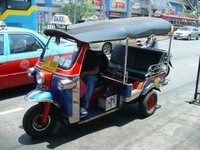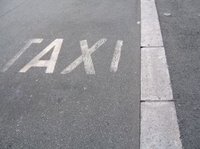Travel: T's Taxi Tips.

I managed to finish only 30 mins overtime today so I'm a good mood- it also helps I learnt a couple of cool things today in theatre- subcuticular sutures and all that.
Anyway, long the short of it, you'll get my Taxi Tips 2 days ahead of schedule. What you'll here is the distilled knowledge of my many trips to all many major continents and mad taxi destinations. Jakarta. Phomn Phenn. Dar Es Salaam. Kuala Lumpur. London. Saigon. All of these have their own rules of the road when it comes to Taxis, but many of these rules overlap so here we go...
Rule #1: Choose your taxi wisely. A run down heap will breakdown, I once chose a Tuk Tuk with a shark emblazoned over the 'nose'. My mate hurled from the swerving and speed about 2 minutes later. Not good. Look for respectable cars, from respectable companies, that will lower the chance of something dodgy happening.
Rule #2: Agree on a price before getting into the car. No misunderstandings there. Get in and you're at the mercy of the driver. And you don't want that. Of course, if it's a metered cab, don't be an idiot and try to haggle beforehand. Now that would be pushing it. A lot.

Rule #3: The safest place to sit is behind the driver. If you are travelling alone, never sit in the passenger seat. Even if you ignore the statistic that more passengers than drivers get killed in car accidents, it places you straight into firing/stabbing line. Furthermore, if the car stops, you can't really make a quick break for it. Behind the driver gives you a clear view both sides, a good view of driver and car movement. Plus, it's pretty darned hard to stab someone sitting you.
Rule #4: Watch your belongings. If you place stuff in the boot, at least be aware of the boot. It's easy to have stuff boosted from off the back of a car/van. It happens all the time over in the East of London, but for some reason not in Africa. Maybe they prefer to beat you up then take your stuff.

Rule #5: Stick to the agreement. You'll get a lot of taxidrivers especially in Africa and Asia who will agree on a price but drive to a petrol station and demand additional cash for fuel. Or engine oil. Or celery. Okay I made that last one up but you get the idea. Stick to your agreement. If that doesn't work, stick to your guns. That usually works.
Rule #6: Get your stuff together, then pay. You need to get your shit together, make sure everything is cool, then pay. I've seen slipper wearing, sarong slinging German tourists chasing after luggage laden tuk-tuks in Bangkok. Okay maybe they weren't German, but they could have been.
Anyway go alleviate the serious of the above content, I'll give a hall of shame run down of the worst things that can happen Taxi wise in the various cities I listed above. Hah. You thought that was just pointless characters...

Jakarta-2005-Car. Well, we were a party of 3 taking a Blue Bird cab from the Airport to a hotel. Price agreed, stuff sorted, gang in car, cruising to Beyonce. Sweet... Enter anti-Sutarto protesters in front of cab. Big ooops, big puddles gathering below our trousers. Anyway, we lay low, pretend to read something. I pull out the only book I have in my case. Which is, a bright yellow Worst Case Scenarios handbook I bought on a whim. Shite. I'd like to say the protesters tried it on and we busted some ass, but they just passed us by. Boooring. Rule #6.5: The worst case scenario book may actually work.
Phomn Phenn-1997-Scooter. In Phomn Phenn, taxis are either rickshaws or scooters. Hmmm, hard choice for a young chap.... handpulled wooden contraption with like 0.5HP or a crotch rocket with a super souped turbo. Group of 5 guys: 3 scooters. Do the math. So one of the guys was riding solo and JH won the toss. We mount (squeeze) up and he just leaps onto his ride with a triumphant smile, only to be greeted by a sound best described as a barbeque sizzle and the smell of burning hair. Queue 2 seconds of puzzlement on his face and then all hell broke loose. He jumped off the scooter, grabbed his water bottle and started to douse his foot with the vodka we stashed in there. Queue much colorful language and more hell. Turns out he stuck his leg right onto the very hot exhaust pipe. So in honor of JH, Rule #6.6: look where you sit and where you limbs go.
Dar Es Salaam-2003-Car. This was the one where the driver asked for more money for petrol. Yeah, right buddy. 4 angry, tired backpackers holding a rapidly warming 6 pack do not a congenial crowd make.
Kuala Lumpur-2005-Car. Got into the big central bus terminal in KL and started to look for our hotel. We used a pretty crude street map pinched from a Singapore hotel, but it was getting dark and my travelling companion was a nervous female so we decided to take a cab (read: she decided and make me decide to take a cab). Got a cab, sorted out a price Us$7, the Cab took us up 1 street 2 blocks from the station, did a u-turn, came down 1/3 on the same road. D'oh. In honor of that cock-up: Rule #6.7: locate destination accurately before getting a taxi.
London-2001-Car. Picture staggering out of a bar at 3 in the morning. Picture trying to figure out which way is skyward. Then imagine trying to get a cab with that kind of mental state. We usually go in a group in a minicab (unliscenced taxis). So anyway we acuired one, settled a reasonable price and took off. Well, the problem with minicabs is that they haven't got the knowledge. That is the ordinance survey type of mental image of London. We wanted to go to Putney, but ended up on the opposite side of spellsville (& town) in Brick Lane. So: Rule #6.8: ensure taxi driver knows where he's going.
Saigon-1998-Car. Road accidents are pretty much okay in my book if no one gets hurt. This was on the boundary. We were travelling by cyclo to the Q bar when our driver took a really sharp swerve and the carriage ended up in a horizontal position. We managed to jump ship before any damage was done but everyone, the driver, us, the pedestrians heard a really loud crunching sound. And before that sound a muffled, surprised, squawk. Rule #6.9: Roadkill is tasty when marinated and barbequed.







